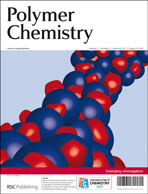The α- and ω-chain-ends of well-defined polystyrene chains were functionalized using consecutive Huisgen cycloadditions. Firstly, an α-alkyne, ω-azido heterotelechelic polystyrene precursor was synthesized in three steps: (i) atom transfer radical polymerization in the presence of (1,1,1-trimethylsilyl)-2-propynyl 2-bromo-2-isobutyrate, (ii) deprotection of the alkyne function of the initiator and (iii) nucleophilic substitution of the bromine chain-end of the polymer with sodium azide. Afterwards, the chain-ends of the polymer were modified by successive nitrile oxide–alkyne cycloaddition (NOAC) and copper-catalyzed azide–alkyne cycloaddition (CuAAC). 2 Model building blocks were tested for NOAC, while 4 building blocks were studied for CuAAC. In all cases, the orthogonal combination of NOAC and CuAAC allowed the preparation of tailored heterotelechelic polymers.
You have access to this article
 Please wait while we load your content...
Something went wrong. Try again?
Please wait while we load your content...
Something went wrong. Try again?


 Please wait while we load your content...
Please wait while we load your content...